Samyang T-S 24 mm f/3.5 ED AS UMC
3. Build quality
The dimensions of the Samyang T-S 24 mm f/3.5 ED AS UMC can be assessed properly if you look at the photo below, where it is positioned next to the Canon EF 50 MM F/1.4 USM.
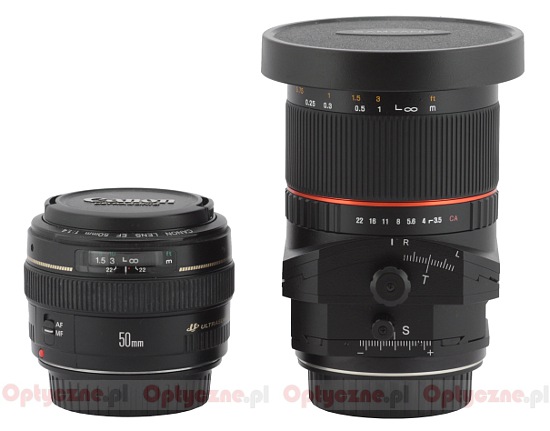 |
Please Support UsIf you enjoy our reviews and articles, and you want us to continue our work please, support our website by donating through PayPal. The funds are going to be used for paying our editorial team, renting servers, and equipping our testing studio; only that way we will be able to continue providing you interesting content for free. |
- - - - - - - - - - - - - - - - - - - - - - - - - - - - - - - - - - - - - - - - - - - - - - - -
The tested lens starts with a metal mount; unfortunately you can’t find any contacts nearby. As such a lack can be forgiven in the case of Samyangs which costs 1,000-1,500 PLN, at a price point of 4,000 PLN, the tested lens’s price range, it cannot be understood and it should be treated as a flaw.
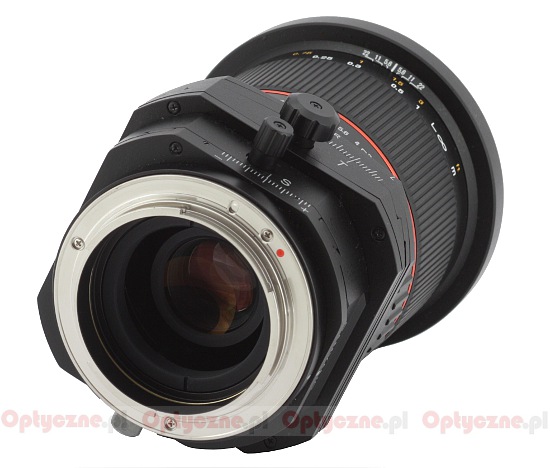 |
Looking inside the tube you can find a rear element, about 2 cm in diameter, which is mobile and set on another narrow tube. It remains the closest to the mount, in the distance of about 2 cm if you set the focus at infinity and it is situated the furthest (in the distance of 4 cm) at the minimum focus, so at 0.2 of a meter.
The rear element tube is surrounded by other structural parts of the lens like transmission gears and mechanisms responsible for those tilts and shifts. Unfortunately their blackening leaves something to be desired – especially the screwbolts moving on transmission gears shine in all their brass glory.
The proper casing of the lens starts with a narrow, immobile ring with just one element – a gray blockade of the whole optical system revolving around its optical axis. It makes a 90 degrees turn possible, divided into distinct 30-degree steps.
The section of the next element of the tube is square with rounded corners. Looking from above you can find there an inscription SAMYANG T-S 3.5/24 mm. On the left and on the right you get a shift scale ranging from –12 to +12 mm. Above the left side of the scale you can notice a narrow, black dial to regulate the shift and above the right scale – a narrow gray dial which can block that movement.
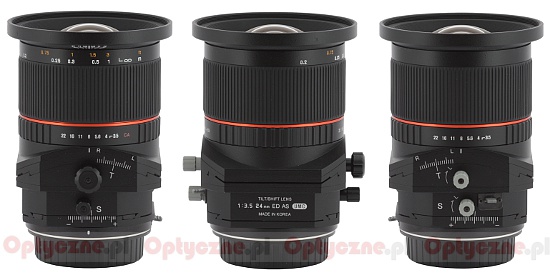 |
Right next to the gray control knob, locking the shift, you can find a tilt lever blockade. Here also the range of the turn amounts to 90 degrees every 30-degree step.
The next segment operates the tilt – you can find there a blockade dial (small and gray) and tilt regulation dial (bigger and black). there is also a tilt scale from 8R to 8L on both sides of it.
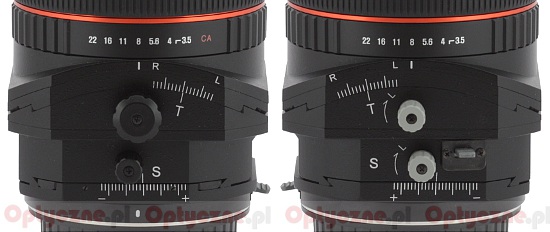 |
Now we have to stop for a while and write something about the performance of all these lock knobs and dials. First of all they are narrow – noticeably smaller and narrower than those of the lens’s immediate rivals. As a result they turn heavily and are hardly comfortable to use - after a very short time the tips of your fingers start to ache. Also their overall performance leaves a lot to be desired. I admit I am used to a quite different situation, especially when it comes to the lock dial. If I tighten it to the maximum I expect it to block the shift completely and its partial loosening should result in a gradual, slow, controllable shifting, with the help of the other dial. Here, meanwhile we deal with an “either-or” situation - either the blockade is tightened and you can’t shift the lens at all or it is loosened and then the shift part of the lens can move uncontrollably under the weight of the whole set. As a result I didn’t touch the shift dial almost at all – it wasn’t worth the pain in my fingers. When I wanted to set a necessary shift value I unscrewed the blockade completely, shifted the whole optical system keeping the lens in my hand and then I screwed the blockade back. It was hardly comfortable or handy, especially that in some situations the operation made it impossible to obtain very precise settings and apply micro adjustments. If you want to adjust the position of the lens just slightly you have to unscrew the blockade and then the lens can slide into the extreme end of the scale under its own weight before you manage to react at all.
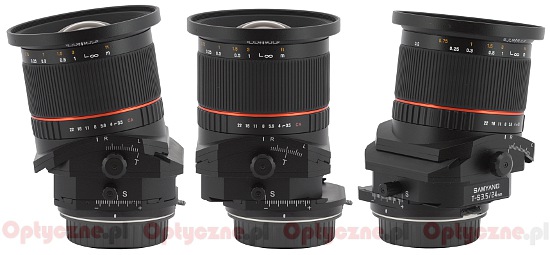 |
An aperture ring is another part of this lens’s casing. Its working range stretches from f/3.5 to f/22 and it can be changed every 0.5 EV step. As the lens doesn’t have any contacts you can’t control the aperture in your camera’s menu so the 0.3 EV step change is unavailable. The ring works well and the only thing you can carp about is its width – it could have been wider than just 1 cm.
Further on you see a manual focus ring. It is very wide for a change, 39 mm no less. Most of it is covered by rubber ribbing above which you can find a distance scale expressed in meters and feet. Running through the whole distance scale range takes a turn through 90 degrees. It is interesting, however, that the range from 1 meter to infinity takes a turn through just 10 degrees – the rest serves the 0.2 – 1 meter range.
Unfortunately the ring doesn’t work smoothly - the resistance is noticeably lower at both ends and it increases in the middle. It’s not a piece of good news – the slack in the range from 1 meter to infinity is so pronounced that often we managed to change the focus catching accidentally the ring when we just tried to change the aperture. Eliminating the slack and increasing the dimensions of the aperture ring would make this problem disappear.
Near the very end of the lens you can also find a small depth of field scale with markings for f/5.6, f/11 and f/22.
The front element of the lens is distinctly convex, with a diameter of almost 5 cm. It is surrounded by a non-rotating filter thread, 82 mm in diameter.
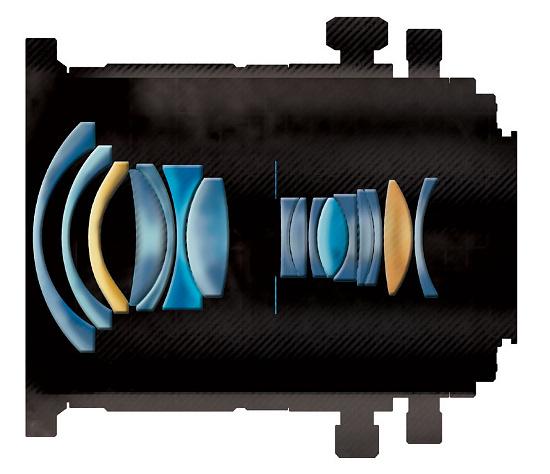 |
When it comes to the optical construction you deal here with 16 elements positioned in 11 groups. Among them you can find two aspherical elements and two made of ED glass with a very low dispersion factor. Inside you can also find an aperture with six blades which can be closed down to a value of f/22.
When it comes to additional accessories the producer adds two caps and a soft pouch in the box. In the photo below the lens was photographed with a temporary front cap.
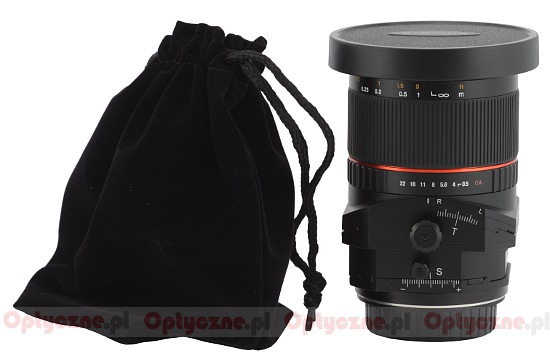 |
As we are going to describe the performance of the lens for different tilt and shift combinations in next chapters here you can find the zero position in relation to which all other operations will be performed. You look at the tilt scale from above and the shift scale is on the left and on the right, with positive values climbing up.
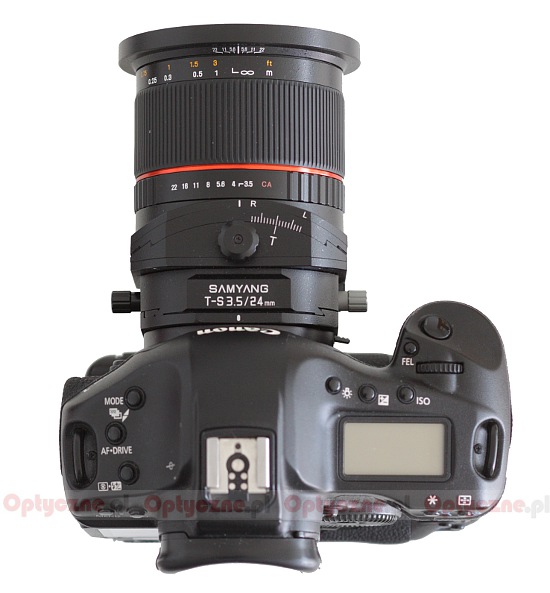 |






